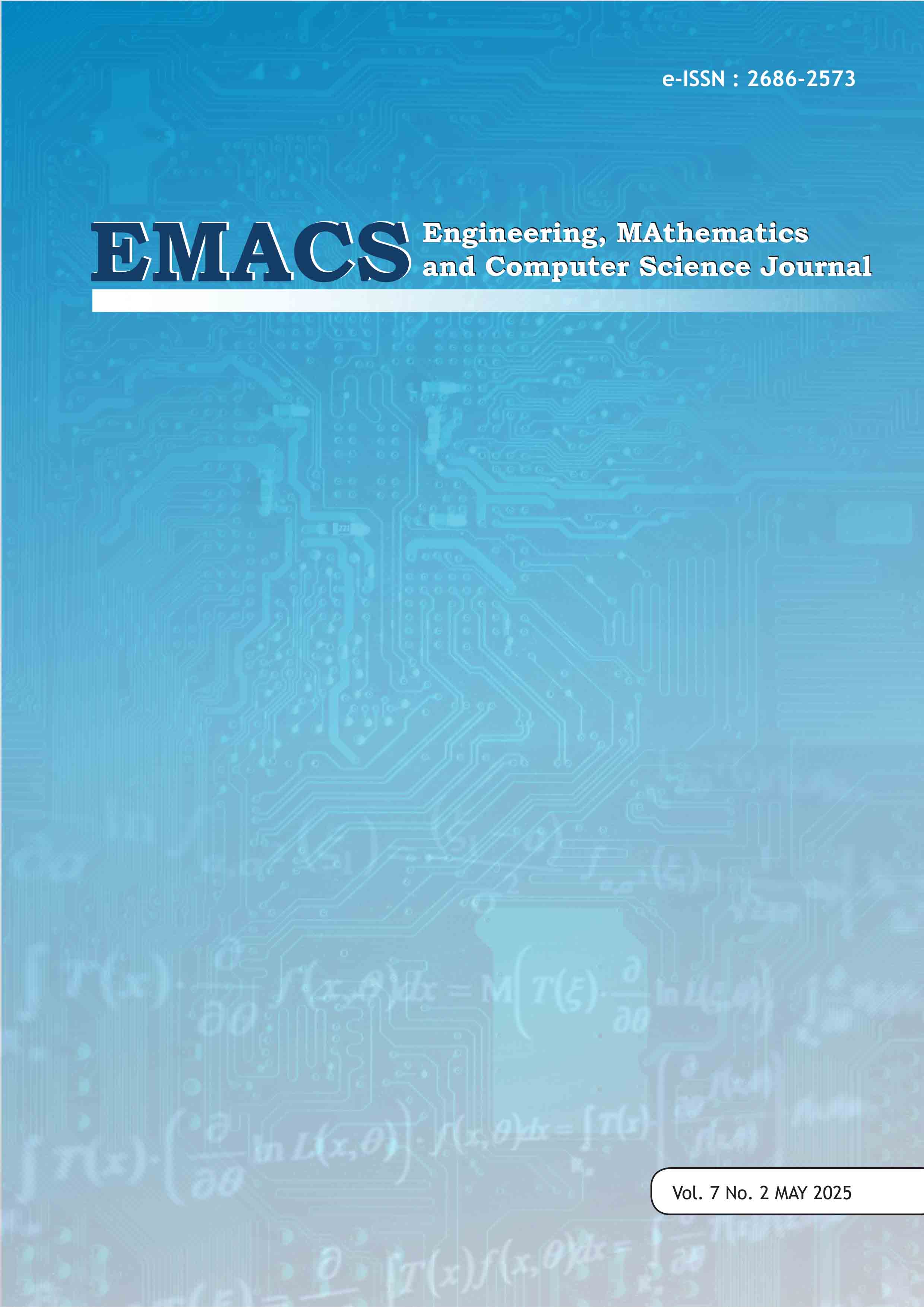Breast Cancer Diagnosis Based on a Hybrid Genetic Algorithm and Neural Network Architecture
DOI:
https://doi.org/10.21512/emacsjournal.v7i2.13409Keywords:
Breast Cancer, Classification, Genetic Algorithm, Neural Network, Multilayer PerceptronAbstract
Breast cancer is one of the diseases with a high prevalence and is a leading cause of death among women. Early detection is crucial in improving patient survival rates. However, a major challenge in diagnosis using machine learning methods is the high dimensionality of the data, which can lead to overfitting and reduced interpretability of the model. This study proposes a new approach to improve breast cancer prediction accuracy by using a combination of Genetic Algorithm + Neural Network (GA + NN). The dataset used is the Breast Cancer Wisconsin (Diagnostic) Data Set, consisting of 569 samples with 32 numerical features that describe the characteristics of tumor cells. The experimental results show that the GA + MLP method achieved the highest accuracy of 99.42%, outperforming the benchmark model using PCA and logistic regression with an accuracy of 97.37%. This approach demonstrates that GA-based feature selection can improve prediction accuracy while reducing model complexity, making it more efficient for medical applications.
References
Afrin, S., Javed Mehedi Shamrat, F. M., Nibir, T. I., Muntasim, M. F., Moharram, M. S., Imran, M. M., & Abdulla, M. (2021). Supervised machine learning based liver disease prediction approach with LASSO feature selection. Bulletin of Electrical Engineering and Informatics, 10(6), 3369–3376. https://doi.org/10.11591/EEI.V10I6.3242
Breast cancer. (n.d.). Retrieved April 21, 2025, from https://www.who.int/news-room/fact-sheets/detail/breast-cancer
Breast Cancer Wisconsin (Diagnostic) - UCI Machine Learning Repository. (n.d.). Retrieved April 21, 2025, from https://archive.ics.uci.edu/dataset/17/breast+cancer+wisconsin+diagnostic
Chen, Y., Ding, W., Huang, J., Zhang, W., & Zhou, T. (2025). Multigranularity Fuzzy Autoencoder for Discriminative Feature Selection in High-Dimensional Data. IEEE Transactions on Neural Networks and Learning Systems. https://doi.org/10.1109/TNNLS.2025.3569893
Hasan, Moh. A., Riyanto, Y., & Riana, D. (2021). Grape leaf image disease classification using CNN-VGG16 model. Jurnal Teknologi Dan Sistem Komputer, 9(4), 218–223. https://doi.org/10.14710/jtsiskom.2021.14013
He, X., & Chen, Y. (2021). Modifications of the Multi-Layer Perceptron for Hyperspectral Image Classification. Remote Sensing 2021, Vol. 13, Page 3547, 13(17), 3547. https://doi.org/10.3390/RS13173547
Idrissi, M. A. J., Ramchoun, H., Ghanou, Y., & Ettaouil, M. (2016). Genetic algorithm for neural network architecture optimization. Proceedings of the 3rd IEEE International Conference on Logistics Operations Management, GOL 2016. https://doi.org/10.1109/GOL.2016.7731699
Kusuma, J., Hayadi, B. H., Wanayumini, W., & Rosnelly, R. (2022). Komparasi Metode Multi Layer Perceptron (MLP) dan Support Vector Machine (SVM) untuk Klasifikasi Kanker Payudara. MIND (Multimedia Artificial Intelligent Networking Database) Journal, 7(1), 51–60. https://doi.org/10.26760/MINDJOURNAL.V7I1.51-60
Laghmati, S., Hamida, S., Hicham, K., Cherradi, B., & Tmiri, A. (2024). An improved breast cancer disease prediction system using ML and PCA. Multimedia Tools and Applications, 83(11), 33785–33821. https://doi.org/10.1007/S11042-023-16874-W/METRICS
Mangukiya, M., & Vaghani, A. (2022). Breast Cancer Detection with Machine Learning. 10. https://doi.org/10.22214/ijraset.2022.40204
Pham, T. A., Tran, V. Q., Vu, H. L. T., & Ly, H. B. (2020). Design deep neural network architecture using a genetic algorithm for estimation of pile bearing capacity. PLOS ONE, 15(12), e0243030. https://doi.org/10.1371/JOURNAL.PONE.0243030
Raj, R., Jyoti, Singh, A., & Kumar, K. (2024). Machine Learning in Medical Diagnosis of Cancer. 2024 IEEE 9th International Conference for Convergence in Technology, I2CT 2024. https://doi.org/10.1109/I2CT61223.2024.10544354
Rashedi, K. A., Ismail, M. T., Al Wadi, S., Serroukh, A., Alshammari, T. S., & Jaber, J. J. (2024). Multi-Layer Perceptron-Based Classification with Application to Outlier Detection in Saudi Arabia Stock Returns. Journal of Risk and Financial Management 2024, Vol. 17, Page 69, 17(2), 69. https://doi.org/10.3390/JRFM17020069
Rasywir, E., Sinaga, R., & Pratama, Y. (2020). Analisis dan Implementasi Diagnosis Penyakit Sawit dengan Metode Convolutional Neural Network (CNN). Paradigma - Jurnal Komputer Dan Informatika, 22(2). https://doi.org/10.31294/p.v22i2.8907
Rustam, Z., & Kharis, S. A. A. (2020). Comparison of Support Vector Machine Recursive Feature Elimination and Kernel Function as feature selection using Support Vector Machine for lung cancer classification. Journal of Physics: Conference Series, 1442(1), 012027. https://doi.org/10.1088/1742-6596/1442/1/012027
Seethalakshmi B. (2024). Brain Tumor Malignancy Prediction Using Machine Learning Techniques. Irish Interdisciplinary Journal of Science & Research, 08(02), 86–93. https://doi.org/10.46759/iijsr.2024.8210
Sholihati, R. A., Sulistijono, I. A., Risnumawan, A., & Kusumawati, E. (2020). Potato Leaf Disease Classification Using Deep Learning Approach. IES 2020 - International Electronics Symposium: The Role of Autonomous and Intelligent Systems for Human Life and Comfort, 392–397. https://doi.org/10.1109/IES50839.2020.9231784
Sudianto, S., Sripamuji, A. D., Ramadhanti, I. R., Amalia, R. R., Saputra, J., & Prihatnowo, B. (2022). Penerapan Algoritma Support Vector Machine dan Multi-Layer Perceptron pada Klasifikasi Topik Berita. Jurnal Nasional Pendidikan Teknik Informatika: JANAPATI, 11(2), 84–91. https://doi.org/10.23887/JANAPATI.V11I2.44151
Wulandari, I., Yasin, H., & Widiharih, T. (2020). Klasifikasi Citra Digital Bumbu Dan Rempah Dengan Algoritma Convolutional Neural Network (CNN). Jurnal Gaussian, 9(3). https://doi.org/10.14710/j.gauss.v9i3.27416
Zhang, B., & Cao, P. (2019). Classification of high dimensional biomedical data based on feature selection using redundant removal. PLoS ONE, 14(4), e0214406. https://doi.org/10.1371/JOURNAL.PONE.0214406
Downloads
Published
How to Cite
Issue
Section
License
Copyright (c) 2025 Rifqi Alfinnur Charisma, Ayu Maulina

This work is licensed under a Creative Commons Attribution-ShareAlike 4.0 International License.
Authors who publish with this journal agree to the following terms:
- Authors retain copyright and grant the journal right of first publication with the work simultaneously licensed under a Creative Commons Attribution License - Share Alike that allows others to share the work with an acknowledgment of the work's authorship and initial publication in this journal.
- Authors are able to enter into separate, additional contractual arrangements for the non-exclusive distribution of the journal's published version of the work (e.g., post it to an institutional repository or publish it in a book), with an acknowledgment of its initial publication in this journal.
- Authors are permitted and encouraged to post their work online (e.g., in institutional repositories or on their website) prior to and during the submission process, as it can lead to productive exchanges, as well as earlier and greater citation of published work.
USER RIGHTS
All articles published Open Access will be immediately and permanently free for everyone to read and download. We are continuously working with our author communities to select the best choice of license options, currently being defined for this journal as follows: Creative Commons Attribution-Share Alike (CC BY-SA)





